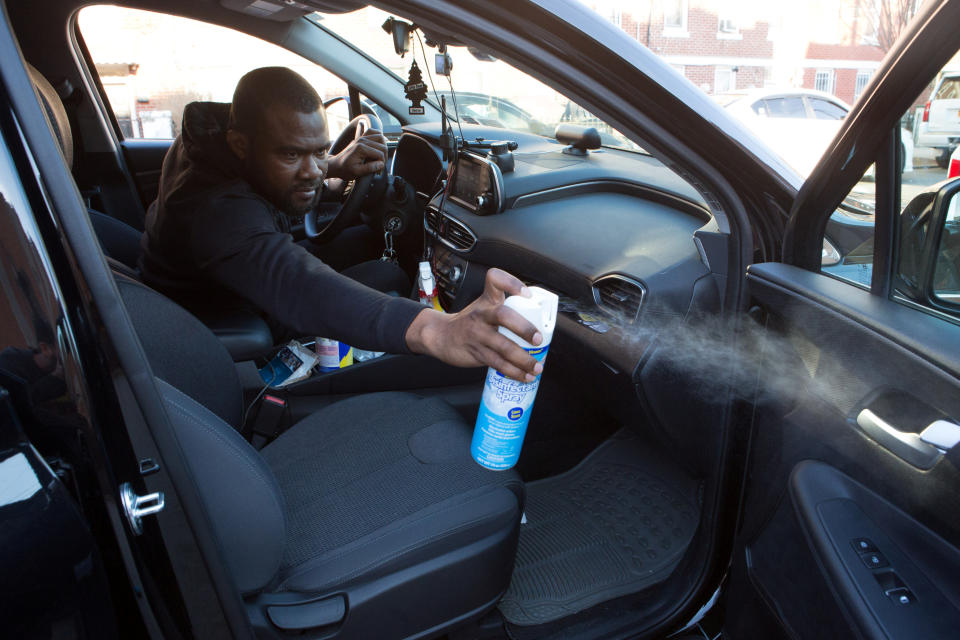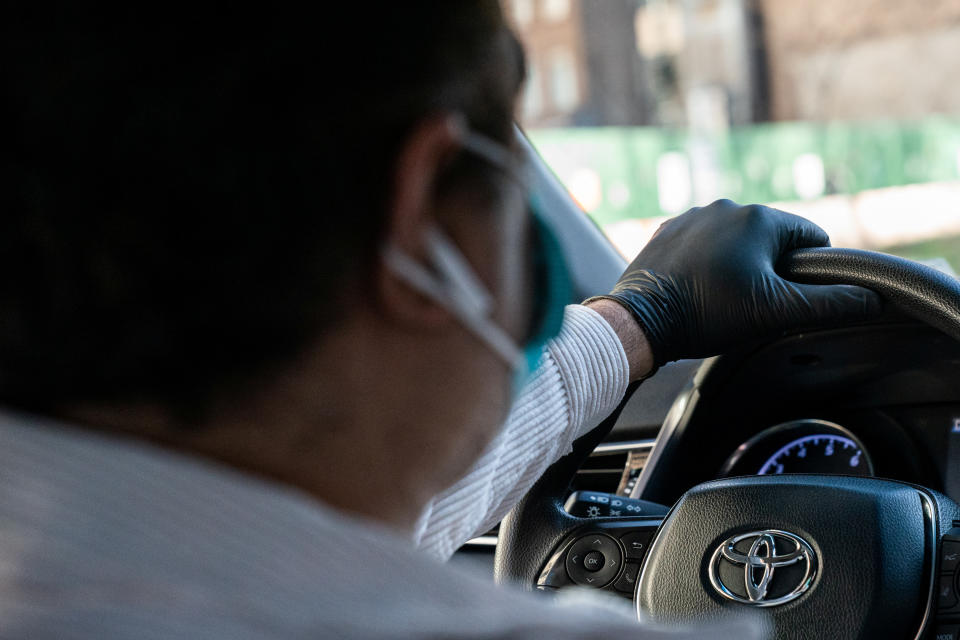‘Hopeless and scared’: Uber and Lyft drivers face financial ruin after coronavirus
As the new coronavirus locks down cities across the world, Uber (UBER) and Lyft (LYFT) drivers face the possibility of financial ruin as more people remain in their homes to rein in the illness.
According to an Edison Trends study released Wednesday, Uber and Lyft rider spending in the two weeks prior to March 15 collapsed by more than 20% in California, and a whopping 40% in Washington State, two of the early hotspots in the U.S. coronavirus outbreak. In the week prior to March 15, Uber ridership in Manhattan alone fell by more than 24%. And those numbers are unlikely to recover anytime soon.
“It is a financial crisis for a lot of people,” says New York-based Uber driver Isjad C., who along with other drivers, didn’t want his full name used out of fear of repercussions from Uber or Lyft.

Citi (C) analyst Itay Michaeli laid out the drop in ridership in a March 18 research note, noting that in the prior seven days, daily active users (DAUs) had dropped significantly. As of March 17, DAUs were down nearly 43% from late-February levels and down 31% from March 1.
Drivers facing huge drops in ridership
Six Uber and Lyft drivers Yahoo Finance spoke with in New York and California said they’ve seen a steep drop-off in the number of passengers looking for rides. With earnings so low, they barely cover fuel costs.
“A lot of Uber drivers I meet, they are pretty much, you know, hopeless and scared that they are going to run out of business really soon,” Isjad C. said.
William J., a driver out of the Los Angeles area, said he’s seen fewer riders, as well. The decrease has been so dramatic that he was unsure how long he could continue to as an Uber driver. The sharp increase in people working from home is easy to see on the roads, he explained. The heavy traffic volume on the highways around L.A., he said, has cut what is normally a two-hour ride to just 40 minutes.
In New York, three drivers said they have seen a stark decrease in riders from Saturday, March 14 to Tuesday, March 17. Over the weekend, the governors of New York, New Jersey, and Connecticut called on restaurants to cut their capacity by 50%, and urged individuals to remain indoors, and avoid large gatherings. On Monday, March 16, New York City closed all restaurants and bars, limiting them to takeout and delivery services.

Further impacting drivers is the fact that both Uber and Lyft, on March 17, announced they have suspended their carpooling options in both the U.S. and Canada for the foreseeable future.
With fewer users seeking rides, some drivers are moving to Uber Eats, or other delivery services to make up for the lost pay, according to at least one driver who spoke to Yahoo Finance. But two drivers said that the pay can’t compare to a standard Uber drive.
According to JMP analyst Ronald Josey, Uber said on a recent conference call that it has seen a 10-fold increase in restaurants signing up for Uber Eats since last Thursday.
Protecting drivers
Outside of the slowdown in ridership, drivers also have to contend with their personal safety, as they continue to ferry passengers who might have the virus themselves. At least one driver told Yahoo Finance he’s concerned he’ll catch the virus from the passengers he picks up while on the road, but can’t afford to turn down rides.
One driver wore a surgical mask while driving me to the New World Mall in Flushing, Queens; he displayed a sign in the backseat of his vehicle explaining it was meant to protect him from potentially sick passengers.
In instances where drivers do contract the coronavirus, both Uber and Lyft are offering 14 days of paid sick leave payments. Uber said it will calculate driver pay based on their daily average earnings for the last 6 months. Lyft is offering drivers payments based on their last four weeks of earnings.
To get those payments, drivers will have to provide documentation from doctors, or other authorities stating that they’ve been diagnosed with the virus, or have been told to self-quarantine due to potential exposure to an infected person.
But drivers who aren’t infected with the virus or exposed to it have no recourse. And with the coronavirus expected to continue spreading across the country for the coming months, with President Trump saying it could take until August to see a decrease in cases, there’s likely little in the way of relief on its way anytime soon.
Nate M. is an Uber driver in Las Vegas. As someone with alopecia universalis, a condition thought to be caused by an autoimmune reaction in which a person’s immune system attacks their hair follicles, Nate said he feared the potential of additional complications if he became infected with the coronavirus while driving.
“I want to say it might have been a week ago is the last time I drove,” he said. “And I just figured it’s not really worth it for me right now. And those days that I did drive, I was driving very limited just to be cautious, and it was also very slow.”
“If you have an autoimmune disorder you’re much more at risk. So I’m just like, you know what, it’s best to stay away from this.”
Nate said he reached out to Uber for assistance, since he has an existing condition he says could become exacerbated by the virus. But he was turned down.
“I didn’t want to risk that, so I did reach out to them to ask, ‘Hey, I have an autoimmune disorder, I’m terrified to work, and it’s not safe, and I shouldn’t have to do that. I shouldn’t be penalized for doing what’s right. I’m protecting myself, and preventing the spread to others.’ ”
In a statement Uber told Yahoo Finance that the provisions it has in place are specifically for those who are infected with the coronavirus, or are under quarantine orders. We reached out to Lyft for comment on its policies but did not receive an immediate response.
The coronavirus isn’t just hurting Uber and Lyft drivers. It will also likely hurt the ride-hailing companies themselves. RBC analyst Mark Mahaney laid out three potential “worst case” scenarios in a recent note modeling a 50% year-over-year decline in rides bookings. In the first scenario, Mahaney sees Uber returning to 20% growth by Q3, while the second scenario sees recovery coming in Q4. The final scenario sees Uber taking a hit throughout 2020, and not recovering until 2021.
Drivers, however, may not be able to last as long as even the first of those three scenarios.
More from Dan:
Microsoft and Slack add millions of users amid coronavirus lockdowns
Here’s where to get your iPhone fixed with Apple closing stores around the world
Internet providers are cutting data caps, speeding up service as more Americans work from home
Got a tip? Email Daniel Howley at danielphowley@protonmail.com or dhowley@yahoofinance.com, and follow him on Twitter at @DanielHowley.
Follow Yahoo Finance on Twitter, Facebook, Instagram, Flipboard, SmartNews, LinkedIn, YouTube, and reddit.

 Yahoo Finance
Yahoo Finance 
